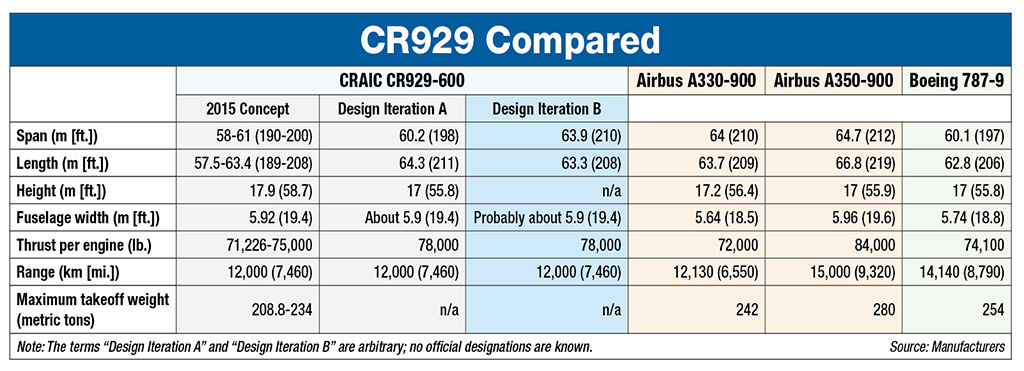Phone: +86 21 51559030
contact@galleon.cc
Craic CR929 Now Larger Than Airbus A330
Oct 16,2018Bradley Perrett and Maxim Pyadushkin | Aviation Week & Space Technology
The Sino-Russian Craic CR929 widebody airliner has grown during development and now requires greater thrust than envisaged before program launch last year. The aircraft, comparable with theAirbus A330-900 in a 2015 concept design, is now rather larger: It is approximately the same length as the Airbus aircraft but has a wider fuselage, enough for nine-abreast economy seating.
An engine type generating 78,000 lb. thrust is now needed; in 2015, thrust per engine was 71,226¨C75,000 lb.
Craic is a consortium of Comac and United Aircraft Corp. (UAC). Comac has released basic data for one preliminary design iteration; UAC unit Sukhoi Commercial Aircraft has provided figures for another, evidently the latest one. Differences presumably reflect progress in refining characteristics.
Dimensions and thrust have crept up from the original concept design¡¯s
But Comac and UAC are sticking to 12,000-km range
Range in both available design iterations remains as it was in the 2015 concept: 12,000 km (7,460 mi.), about the same as for the A330-900 and Boeing 787-10. This is enough to cover 95% of medium- and long-haul routes, says Comac.
In the design described by Sukhoi, seating in a three-class cabin arrangement is 281. The A330-900 has a typical three-class capacity of 287, says Airbus, but the comparison is almost meaningless, because of the great number of variations in premium cabins in long-haul aircraft.
More telling are fuselage dimensions. These show that the CR929 will carry more passengers than the A330-900 for a given seating standard. The aircraft is now 63.25 m (208 ft.) long, says Sukhoi. That is just 45 cm (18 in.) shorter than the A330-900.
The Russian company does not give the width of the fuselage, but for the preliminary design described by Comac the figure is about 5.9 m. This can be judged from the proportions of a drawing of that design. For the 2015 concept design the precise measurement was 5.92 m, obviously intended for nine-abreast seating. Width is unlikely to have changed much in the design for which Sukhoi provided figures.

This approximate drawing is based on a design published by Comac, called Design Iteration A in the table. Credit: Scott Marshall/AW&ST
The A350, designed for rows of nine seats, has almost the same width, 5.96 m. The A330, by contrast, is wide enough for only eight-abreast seating. Craic has rejected the choice Boeing made with the 787: to design a fuselage that could take rows of eight comfortably wide seats and aisles or nine narrow seats in a squeezed arrangement.
The CR929 is evidently intended mainly to replace the A330-300, which has the same fuselage length as the A330-900, says Sash Tusa from analysis company Agency Partners in London. A330-300s have become the workhorses of China¡¯s busiest domestic routes over the past decade; they will be ripe for replacement in the years after 2027, the latest point at which the CR929 is supposed to be ready for service.
Comac and Sukhoi may have increased the size of the CR929 because they expect airlines to want more seats for A330-300 missions by the time aircraft of that type retire. The design may have been enlarged twice. The chief designer for the CR929 at Comac, Chen Yingchun, said in September 2017 that 75,000 lb. was required. That was at the top end of the band in the 2015 concept design; now an even higher figure is specified.
Comac showed one preliminary design iteration on May 15 at an aeroengine conference in Shanghai organized by Galleon. Sukhoi subsequently provided details at Aviation Week¡¯s specific request, so its figures should relate to the latest design. (In the table shown the two sets of data¡ªfrom Comac and Sukhoi, respectively¡ªare only arbitrarily labeled as Design Iterations A and B; official names for them are unknown.)

Aviation Week published details of the concept design in late 2015 (AW&ST Oct. 12-25, 2015, p. 37). It was defined only approximately by ranges of values, but figures for fuselage dimensions, weight and thrust indicated that the aircraft¡¯s size was in the ballpark of the A330-900¡¯s. Fuselage length is now at the upper end of the concept-design ranges, and the increase in thrust suggests that weight has correspondingly increased.
Span has apparently risen in at least two steps: in the design described by Comac it is in the upper half of the 58-61-m band planned in 2015; in the design detailed by Sukhoi, it is well beyond that band. Indeed, at 63.86 m it is barely less than the values for the A330-900 and A350.
To compete, Craic first needs a Western engine for the CR929, and it requested proposals in December. GE Aviation or Rolls-Royce are the only contenders, because Pratt & Whitney is concentrating on engines for narrowbody aircraft. Chinese and Russian engine companies have proposed alternatives; a merged Sino-Russian engine program is also possible.
In 2016 UAC assumed Rolls-Royce or GE would each offer an engine of about the same technology level as was then available for Airbus or Boeing aircraft. GE¡¯s candidate would probably be a version of the GEnx, which in its GEnx-1B76 standard produces 76,100 lb. thrust for the 787-10. Rolls-Royce is likely to offer a version or derivative of the Trent 7000. This is rated at only 68,000¨C72,000 lb. for the A330-900 but is closely related to the Trent 1000 TEN of the 787, which the FAA has certified at 78,129 lb.
A consideration for the engine-makers is that Craic is likely to want the chosen turbofan to have spare thrust for the planned stretched version of the CR929.
¡ªWith Guy Norris in Los Angeles
This article has been updated to indicate that Craic is developing the CR929 and that the fuselage width for Design Iteration A is about 5.9 m (19.4 ft.).
